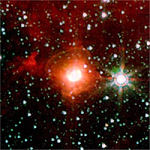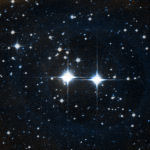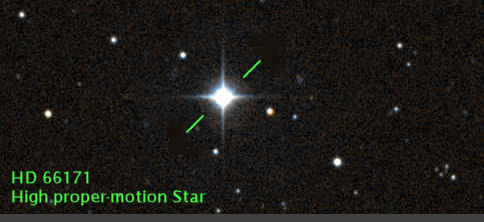§ Stars and the Luminosity Class
Page 3The Yerkes spectral classification, also called the MKK system from the authors' initials, is a system of stellar spectral classification introduced in 1943 by William Wilson Morgan, Phillip C. Keenan and Edith Kellman from Yerkes Observatory.This two-dimensional (temperature and luminosity) classification scheme is based on spectral lines sensitive to stellar temperature and surface gravity which is related to luminosity (whilst the Harvard classification is based on surface temperature only!). Later, in 1953, after some revisions of list of standard stars and classification criteria, the scheme was named MK (by William Wilson Morgan and Phillip C. Keenan initials). — Yerkes spectral classification from Wikipedia
§ Contents
- You Should Know — Star Terminology & Information
In This Section You Should Know — Definitions from the Astronomical Science of Stars - Stars — Introduction
A Jeweled Pair — Albireo A & B - The Stellar Classification of Stars
The H-R Diagram — O, B, A, F, G, K, and M - History of the H-R Diagram
Amateur Astronomer: Ejnar Hertzsprung — Influential Astronomer: Henry Norris Russell - History of the H-R Diagram...continued
Amateur Astronomer: Ejnar Hertzsprung — Influential Astronomer: Henry Norris Russell - Evolution within an Evolving Universe
Evolution of the Universe & Universal Evolution — Stellar Evolution - Spectral Classification of Stars
Star HD 66171 — Spectral Classification, Counting Photons - The Luminosity Class
Luminosity class, A Star's Radius & Temperature — Apparent Magnitude - Sources & Further Study
Additional Resources - Star Types
Introduction to Star Types — Most of the Older Pages Displayed, Revisions in Progress
8. The Luminosity Class
the formula E ≈ σ Teff4

 A Luminous Blue Variable star named HD168625, located in our Milky Way Galaxy, is surrounded by a bipolar nebula that is similar to the one around SN1987A, a supernova that exploded in 1987 in the Large Magellanic Cloud and was the nearest supernova to Earth in 400 years. Image Left — NASA, JPL-Caltech, Nathan Smith/UC Berkeley
A Luminous Blue Variable star named HD168625, located in our Milky Way Galaxy, is surrounded by a bipolar nebula that is similar to the one around SN1987A, a supernova that exploded in 1987 in the Large Magellanic Cloud and was the nearest supernova to Earth in 400 years. Image Left — NASA, JPL-Caltech, Nathan Smith/UC BerkeleyImage of HD 168625 and HD 168607 at right is from the Aladin Previewer website. In 2003, survey evidence showed that this pair of rare luminous late type B (early type A) hypergiants may indeed be a "physical pair", a determination made via spectroscopic monitoring. — E. L. Chentsov and E. S. Gorda Luminosity class, A Star's Temperature (T) & Radius (R)
Finishing our section on spectra, we have what is called a star's Luminosity Class and it is expressed using the Roman numerals I to V, as in our example from the previous page, HD 66171 which was a G2 V class star. This is the energy output by the star every second, and the properties used to determine this are:
E≈ σ; Teff4
E is approximately equal to σ and Teff is raised to the 4th power where:
Teff is the effective temperature in Kelvins
E is the energy per unit surface area in erg/cm2 and
σ is the Stefan-Boltzmann constant, equal to 1.82849716 x 10-23 M Days-3 K-4.
Days-3 K-4.
The effective temperature is the best measure of the actual temperature of the gases in a star's outer layers and this is equal to the temperature of a black body having the same radius and radiating the same amount of energy as the star. Our first task is to look at a star's temperature, remembering from our section II information that the hotter the star the greater the amount of radiation emitted or power output per unit of surface area. An analogy is the household light bulb and dimmer switch. At it's lowest setting the light bulb is dim and not very hot but as we rotate the dimmer switch the bulb begins to brighten, getting hotter, and this results in a greater amount of energy being emitted from it's surface area. The same principle may be applied to stars with the caveat that since the range of stellar luminosities is great our calculations need use of a constant that approximates the relationship between power and temperature. The formula used is:
l ≈ σ T4
l is approximately equal to σ T raised to the 4th power
4π R2
where R is equal to the Radius of the star
(4 pi R squared)
L ≈ 4π R2 σ T4
So now we have all we need in hand to calculate a star's luminosity class - except! Looking at the above calculation begs the question, what is the star's radius? All the above works great if we have a star's radius to begin with but as only some hundreds of star's have had a direct measurement made of their radii the above seems to be rather acemdemic. Not so, as we are able to measure the luminosity of a star via other means - spectroscopic comparison - and through this we can actually use the above equation to determine the radius of the star, thus having in hand the information required to make our calculations (also see: Spectroscopy of Variable Stars for more on calculating a star's absolute luminosity and density via this method).Apparent Magnitude
Before ending this section, let us quickly look at Apparent Magnitude and how we calculate the difference between two stars. Remember, the higher the magnitude number the dimmer the star. So, let's say for example that Φ is a magnitude 11 star and Ω a magnitude 6 star. How many times is one star fainter than the other? Well, the relative magnitude formula is expressed as:
bΦ = 2.512 ( MΩ - MΦ ) bΩ
Where b = the apparent brightness of star Φ and star Ω
M = the apparent magnitude of star Φ and star Ω and
2.512 is raised to ( M Ω - MΦ ) x bΩ
bΦ / bΩ = 2.512(MΩ - MΦ) → bΦ / bΩ = 2.512(5)
or 100 times fainter.
 Keep in mind that the information presented in this section on stars is not definitive, there is still much more involved in this aspect of stellar science. For those wishing a more thorough study and understanding see the following websites:
Keep in mind that the information presented in this section on stars is not definitive, there is still much more involved in this aspect of stellar science. For those wishing a more thorough study and understanding see the following websites:
- Australia Telescope Outreach and Education
The Colors of Stars - Chapter 9: The Life of a Star
AAVSO Variable Star Astronomy - Chapter 9 - Luminosity Class and the HR diagram
Michael Richmond's classes
§ Sources & Further Study
The below are sites with material and information regarding this section's topic of Stars, Specturm, Luminosity and more.- Light Spectrum A well rounded review of the color spectrum by Steve Beeson, Arizona State University
- The Doppler Effect A java applet illustrating the effect with configurable parameters
- Color, Doppler, Red-shift The Sloan Digital Sky Survey's SkyServer website, educational series - well done
- Atomic Spectra Database at the National Institute of Standards and Technology
- Properties of Stars Other Than the Sun Natural Sciences 102 from the University of Arizona, Professor George Rieke
- What Wavelength Goes With a Color? from the Atmospheric Science Data Center
- O-B-A-F-G-K-M Clicking this link will take you to Wikipedia, explaining all those letters via a timeless mnemonic
- The Bohr model Tutorial on Excitation by absorption of light and de-excitation by emission of light
- Hydorgen Emission Lines and Spectral Color Both pages are from Georgia State University and are solid study reference of the science of spectral analysis - pages contain advance math and formulas.
- Christian Buil's Homepage This site is dedicated to the use of electronic detectors in the field of astronomy and spectroscopy
- SBIG's new Deep Space Spectrograph Though this is a retail site for amateur astronomers, it provides a very good overview of the technical and working details of Spectrograph equipment.
- Australia Telescope Outreach and Education website Luminosity of Stars The Australia Telescope is operated as a National Facility under guidelines originally established by the Australian Science and Technology Council.
- Different Star Spectra Examples Here, from the Ph. D. thesis of David Silva , are spectra of certain kinds of stars. The data cover the wavelength range 3500 - 9000 angstroms. From the University of Oregon
- The Spectral Types of Stars by Alan M. MacRobert, Sky & Telescope Article regarding star spectra.